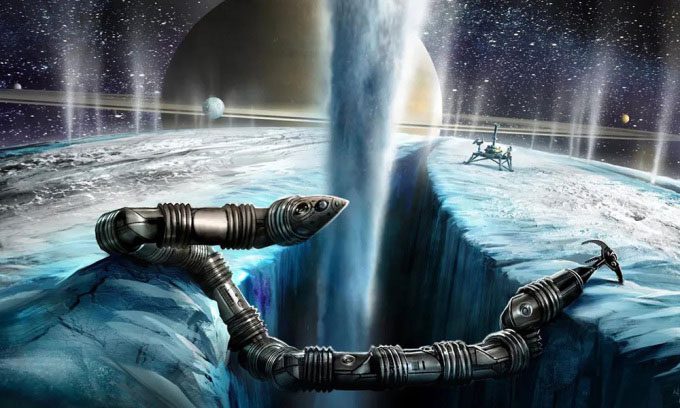The EELS Robot is designed to easily traverse various terrains such as water, sand, rocks, and ice, aiding in the exploration of celestial bodies in the Solar System.
NASA is researching plans to utilize robust robots to explore and search for extraterrestrial life forms within the Solar System. This robot is called the Extraterrestrial Biological Anomaly Surveyor (EELS), developed by the Jet Propulsion Laboratory (JPL) of NASA, as reported by Interesting Engineering on April 13.

Illustration of EELS robot in action. (Photo: NASA/JPL-Caltech)
The EELS can navigate through holes, crevices, and cracks on celestial bodies in the Solar System, allowing for the exploration of deep and hard-to-reach areas. This autonomous robot is also designed to easily traverse various terrains such as water, sand, rocks, and ice. Its ability to change and adjust its shape helps it adapt to different landscapes. Additionally, it features rotating screws to grip and maneuver through icy structures.
The research team recently conducted tests for the robot inside the Athabasca Glacier and Meager Volcano in Canada. This marks the first step in analyzing the robot’s resilience and navigation capabilities across rugged terrain to continue refining its final design.
The development of the EELS robot has been driven by remarkable discoveries of water vapor plumes that the icy moon Enceladus of Saturn emits into space. This increases the potential for a habitable liquid ocean beneath Enceladus’s icy crust.
Scientists and engineers hope to study the geyser systems on Enceladus by guiding the EELS through the cracks on this moon. “The adaptability of EELS opens up potential for exploring various destinations such as the polar caps on Mars or deep fissures in Earth’s ice sheets,” NASA explained.
The EELS could also assist future astronauts in establishing bases on the Moon. The robot can easily navigate through lava tubes and depressions while identifying the location and quantity of water present on the Moon’s surface. These remote locations are difficult to access, but the robust robot can operate efficiently there, sending back valuable data to Earth. The team at NASA is working diligently to finalize improvements to the EELS.





















































